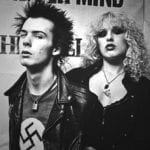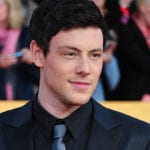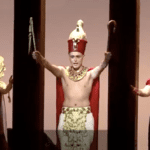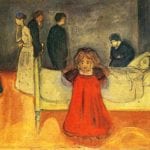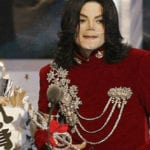 Mysteries
Mysteries  Mysteries
Mysteries  History
History 10 Surprising Stories About the Texas Rangers
 Humans
Humans 10 Philosophers Who Were Driven Mad by Their Own Theories
 Miscellaneous
Miscellaneous 10 Video-Game-Worthy Weapons and Armors from History
 Weird Stuff
Weird Stuff 10 Psychics Who Accurately Predicted Wartime Events
 The Arts
The Arts 10 Pieces of Art Inspired by a Broken Heart
 Health
Health 10 Science Fiction-Sounding New Medical Treatments
 History
History 10 Surprising Facts About the Father of Submarine Warfare
 Space
Space Ten Astonishing New Insights into Alien Worlds
 Weird Stuff
Weird Stuff 10 Bizarre Summer Solstice Rituals Still Practiced Today
 Mysteries
Mysteries Top 10 Haunting Facts About the Ghost Ship MV Alta
 History
History 10 Surprising Stories About the Texas Rangers
 Humans
Humans 10 Philosophers Who Were Driven Mad by Their Own Theories
Who's Behind Listverse?

Jamie Frater
Head Editor
Jamie founded Listverse due to an insatiable desire to share fascinating, obscure, and bizarre facts. He has been a guest speaker on numerous national radio and television stations and is a five time published author.
More About Us Miscellaneous
Miscellaneous 10 Video-Game-Worthy Weapons and Armors from History
 Weird Stuff
Weird Stuff 10 Psychics Who Accurately Predicted Wartime Events
 The Arts
The Arts 10 Pieces of Art Inspired by a Broken Heart
 Health
Health 10 Science Fiction-Sounding New Medical Treatments
 History
History 10 Surprising Facts About the Father of Submarine Warfare
 Space
Space Ten Astonishing New Insights into Alien Worlds
 Weird Stuff
Weird Stuff 10 Bizarre Summer Solstice Rituals Still Practiced Today
10 Groundbreaking Moments in TV History
In May 1914, The Times of London, England, reported: “If all goes well with this invention, we shall soon be able, it seems, to see people at a distance.” The newspaper referred to an instrument an English inventor, Archibald Low, had come up with called a Televista. Low’s Televista was the most sophisticated device of the day, but it was a long way from being anything we would recognize as a television. And Low was not the only one working in the field.
No single person can be credited with the invention; many people contributed. A Scot, John Logie Baird, demonstrated a working system at Selfridge’s Department Store in London in 1925. In the United States, Charles Francis Jenkins was making great advances in the same year, and in Japan, Kenjiro Takayanagi demonstrated a system with much-improved resolution in 1926.
The world’s first TV station—W2XB—started broadcasting from New York City in 1928. The idea that television would be a vehicle for mass entertainment didn’t occur to these pioneers-that would have to wait until after the Second World War.
The examples here are sandwiched between Queen Elizabeth’s coronation and her funeral. In her long reign, she witnessed the growth of television from a relatively minor, expensive luxury to the ever-present phenomenon it is today. She also witnessed the following groundbreaking moments.
Related: Top 10 Iconic Moments From The History Of Music
10 Elizabeth Takes Up the Crown
People needed something to cheer them up in a country still feeling the effects of World War II. What better than a pageant like a royal coronation? The queen demonstrated that she understood the medium’s power by insisting that the BBC could place cameras inside Westminster Abbey—something that her advisors insisted would detract from the mystery of the monarchy. But Elizabeth was not interested in mystery. She wanted to be the figurehead of a united Commonwealth.
Twenty million people watched Queen Elizabeth’s coronation live on June 2, 1953. In Britain, viewers crowded into neighbors’ houses, pubs, and cinemas to enjoy the spectacle. For the first time, more people watched a TV program than listened to a radio broadcast.
In the United States, 85 million Americans watched recorded highlights, eager to see the mysterious ceremony that had alluded so many for so long.
9 The First Step
Using a 30-line mechanical system, the BBC broadcast its first program in August 1932. John Logie Baird made an appearance to thank the corporation, and “lookers-in” (as viewers were called) also saw a performing sea lion, a demonstration of ju-jitsu, and other bits and pieces.
Our clip shows that the USA then took things a little further. At the beginning of the program, the two RCA men stress that there are still a lot of technical problems to overcome. Interestingly, they mention that television has an educational role and would be an extension of radio rather than a threat to radio.
The production quality of this program is surprisingly good, and the two men are confident that this is just the beginning. Perhaps the greatest problem would be how to make television receivers affordable.
8 Walter Cronkite Announces JFK’s Assassination
We’ve probably all seen the famous footage of the assassination of JFK in 1963. But the film was not from live TV coverage—Abraham Zapruder recorded the part of the motorcade that he could see on silent 8mm film. TV crews were waiting for President Kennedy to arrive at the Dallas Trade Mart.
Nobody thought the motorcade was important enough to call for live coverage. In hindsight, this was a pity, given the amount of speculation that is still going on about what happened that day. Reporters were quick to phone in the news. Around 70% of Americans heard about the event within half an hour of it happening.
Our clip shows how Walter Cronkite handled the news of President Kennedy’s death when sources confirmed that the President had died. Many people considered Cronkite “the most trusted man in America.” His professionalism comes through in this clip. He is affected by the news, and we can see that, but he doesn’t let his emotions get the better of him. After a short pause, he finishes the bulletin with calm confidence.
Many people knew that Kennedy had been shot, but they had no idea how serious it was. Many people heard the news that he had died from Cronkite.
7 Doctor Who?
On a more frivolous note, the day after Kennedy’s assassination, the BBC released the first episode of Doctor Who. The Time Lord is still going strong today and has an enormous international cult following.
Looking back at old episodes, the props seem amateurish and obviously fake. But the program always had (and still has) strong plot lines, a good cast, and an engaging touch of humor. The technical quality of the programs has, of course, improved beyond measure, but the program still retains its tongue-in-cheek touch.
Who can forget the first time they saw a Dalek? I can’t—at the age of seven, I hid behind the sofa!
6 Neil Armstrong on the Moon
For those of us who are old enough to remember the Apollo 11 mission, Neil Armstrong stepping onto the moon’s surface is an unforgettable moment. We seemed to be on the verge of conquering space; science fiction was suddenly real.
In 1961, President Kennedy set the goal of reaching the moon before the end of the sixties. Considering the available technology, it must have seemed an impossible task to most people. But the men and women of NASA buckled down to the job and delivered spectacularly.
When Neil Armstrong took his first steps on the face of the moon, he stated, “That’s one small step for man. One giant leap for mankind.” Neil Armstrong himself actually said the above was a misquote, reported on every news channel of the time. He later stated, “That’s one small step for a man…”. But, given that Armstrong’s transmission was from 238,900 miles away, I think we can forgive the media this once!
For many years, the Soviets claimed they had never been interested in a manned mission to the moon and said that the U.S. was wasting money and taking risks for theatrical reasons. In fact, we now know that they did want to beat the United States there and lost out.
5 Challenger Explodes
On January 28, 1986, the space shuttle Challenger set off on its mission from the Cape Canaveral launch facility in Florida. It reached a height of 46,000 feet before its solid rocket booster exploded and blew the whole assembly apart. The crew of seven was killed. Although there is evidence that some survived the initial explosion, there was no way of escaping the disintegrating craft.
A tragedy under any circumstances, but this was perhaps made even worse by the fact that the Challenger was carrying a school teacher, Christa McAuliffe, and many of her schoolchildren were eagerly watching the launch.
Two o-ring seals had failed; they were made brittle by unseasonably cold weather at the launch pad. Pressurized gas leaked out, a propellant tank was damaged, and the contents ignited. The spacecraft twisted, and aerodynamic forces ripped it apart. The crew had no chance.
Space programs carry risks, and, unfortunately, accidents happen. We learn a little more from each one.
4 The Simpsons’ First Appearance
On April 19, 1987, The Tracey Ullman Show ran a short featuring some new animated characters. It was the start of a phenomenon that is still going strong today. The intelligent scripts, the well-defined characters, and the irreverent humor redefined animation.
The Simpsons appeals to young and old alike. Some may disapprove and believe that it’s not suitable for young children. It’s certainly true that The Simpsons is not very politically correct, that Homer drinks too much beer, and isn’t the brightest of men. But the family is strong and united. The values that the program promotes are values that we all should share. Love and loyalty are not the least among them.
A poll in Great Britain revealed that The Simpsons were more popular than the British royal family. A show that seems to be very American is widely watched all over the world. It hits all the right notes.
3 Breaching the Berlin Wall
After the Second World War, military power was divided into two camps. The West was led by the United States, and the East by the Soviet Union. The relationship between the two powers had moments of relative calm but many more moments of high tension. With both having enough nuclear weapons to wipe us all out, it’s no wonder that people often worried about the future.
When the Soviet system collapsed—demonstrated by the fall of the Berlin Wall in 1989—it seemed that a new era might be possible. Most who witnessed East Germans freely crossing into West Germany believed that they were seeing something truly groundbreaking on live TV, and they truly were.
The political map is different now, but perhaps, things haven’t worked out as we hoped. In many ways, when there were only two players on the stage, things were simpler. The world looks a lot more complicated these days.
2 A Long Time Coming
The American drama series Dawson’s Creek ran for six seasons starting in 1998. The popular show followed the fortunes of Dawson and his pal, Joey, as they went through their teenage years together. The clip we have here aired in 2000 and shows the first ever gay male kiss to be aired on television. Women were a little ahead—LA Law had shown two women kissing in 1991.
Television producers want to make their shows as popular as possible and know that their potential viewers have a wide range of beliefs and opinions. They were sometimes reluctant to take risks and sometimes ended up behind the times.
The rise of streaming platforms and greater choices for viewers has led producers to be a little more adventurous.
1 Elizabeth at Rest
On September 19, 2022, Britain stood a standstill in recognition of the funeral of Queen Elizabeth II. Some estimates suggest that around 4.1 billion people saw the event. If this is right (and there are some questions about how the figure was calculated), then over half the world’s population watched—making it the biggest live event ever on television.
We started our list with the pomp of a coronation and closed it now with the solemnity of a funeral. In her 70 years on the throne, Elizabeth saw many changes. Television has reflected those changes and, sometimes, helped spark them.

